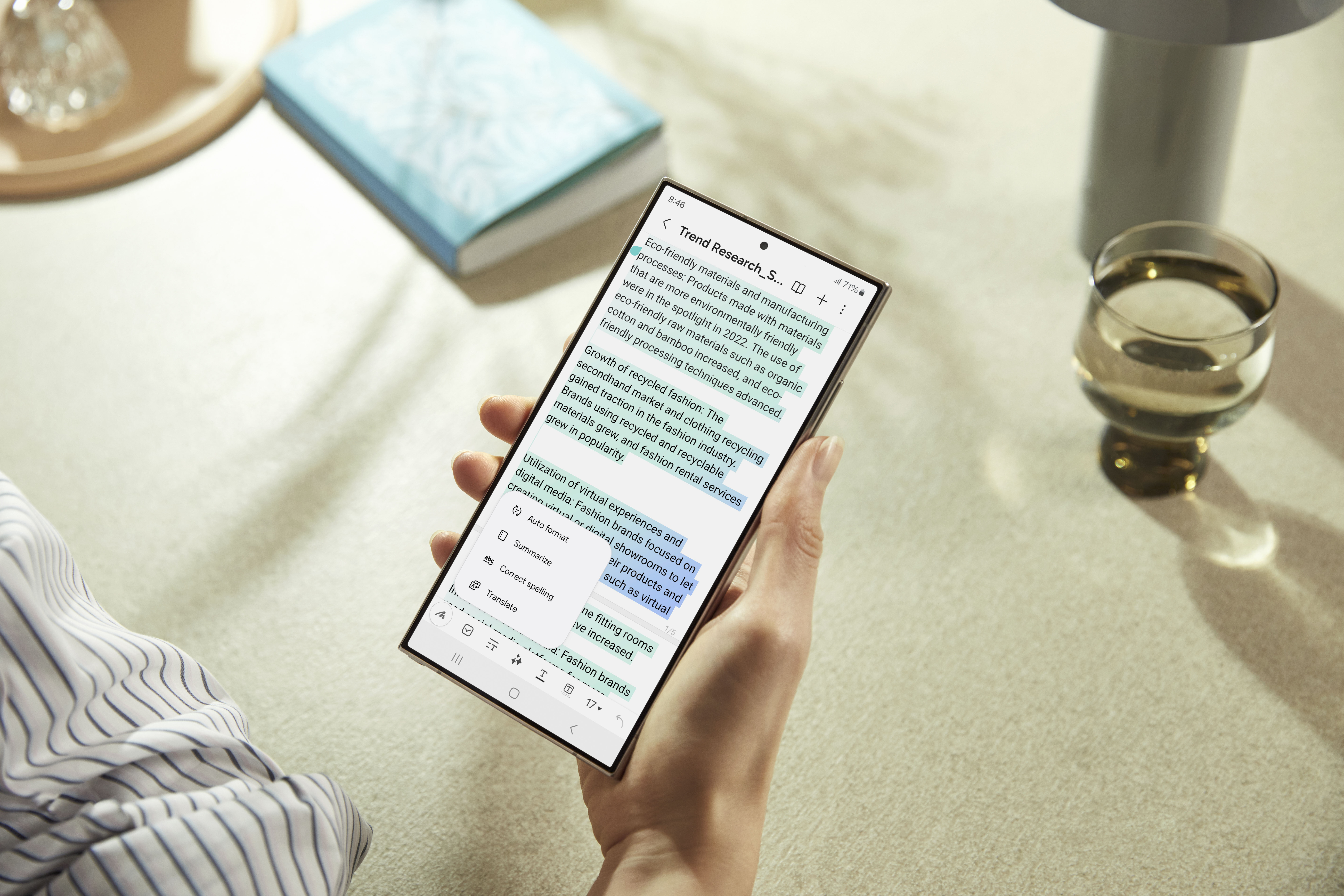
No awards for correctly guessing that today’s big Unpacked news is all about the Samsung Galaxy S24 series. As anticipated, the Korean hardware giant just unveiled its latest flagship line, including the Galaxy S24, Galaxy S24+ and Galaxy S24 Ultra. The devices start at $800, $1,000 and $1,300, respectively.
Also as anticipated, Samsung is leaning heavily into AI for today’s announcement. Phone manufacturers have been talking up artificial intelligence for nearly a decade at this point, but the tech will continue to occupy more mindshare going forward, effectively in the wake of last year’s generative AI explosion.
Samsung may be among the first device manufacturers to position that specific technology as a software enhancement to its smartphone line, but it certainly won’t be the last. I hope you’re not sick of hearing about generative AI quite yet, because the buzzword is going to pervade device launches for at least the next couple of years.
In the case of the S24 line, those enhancements are — perhaps unsurprisingly — largely focused on image editing. Writes Samsung:
After great shots are captured, innovative Galaxy AI editing tools enable simple edits like erase, recompose, and remaster. For easier and more efficient optimizations, Edit Suggestion uses Galaxy AI to suggest perfectly suitable tweaks for each photo. To give users even more creative control and freedom, Generative Edit can fill in parts of an image background with generative AI. When a picture is crooked, AI will fill in the borders.

Any time the device uses generative AI in the editing process, it will add a digital watermark to the image, as well as the meta data, which is a good precedent for this brave new world. That includes another new feature, Instant Slow-mo, which generates additional frames in order to offer a fuller slow motion experience. Very curious to see how seamless that experience is.
Another fun new feature was announced in conjunction with Google this morning. The S24 will be getting Circle for Search, which does pretty much what it says on the tin. Circle a piece of text with a finger or S-Pen and you’ll trigger a Google search on the word. Google tends to launch these kinds of features on its own Pixel devices, so this is an interesting break from recent tradition.
The two companies have, however, been working closely on the software front over the past few years. That includes Google’s launch of a foldable version of Android, as well as Samsung’s long-awaited embrace of Wear OS on its Galaxy Watch devices.

The device will leverage Google’s house model, Gemini Pro. Here’s Google:
With Gemini Pro, our best model for scaling across a wide range of tasks, you can interact with familiar Samsung apps in more helpful ways than ever before. On the new Galaxy S24 series, Samsung’s Notes, Voice Recorder and Keyboard apps will use Gemini Pro to deliver better summarization features. For example, you can record a lecture using Voice Recorder and quickly get a summary of the most important parts of the lesson. And with Imagen 2, Google’s advanced text-to-image diffusion technology, you will be able to access helpful photo editing capabilities using Generative Edit within the Galaxy S24 Gallery app.
Galaxy S24 series will also come built-in with Gemini Nano, the most efficient model for on-device tasks, to enable a new feature in Google Messages and ensure your data doesn’t leave your smartphone. Additionally, Samsung will be one of the first partners to test Gemini Ultra, our largest model for highly-complex tasks, before it is available broadly to developers and enterprise customers later this year.
AI isn’t being limited to post-production this time out. The offering will also play a role in the shots themselves, continuing a push for increased computational photography. The week Apple is showing off the Vision Pro to select reporters, Samsung is talking up “ProVisual,” a new imaging engine.
“Galaxy S24 series’ ProVisual Engine is a comprehensive suite of AI-powered tools that transform image capturing abilities and maximize creative freedom every step of the way, from setting up a shot all the way to sharing it on social,” the company writes, “Gone are shaky, pixelated images taken from far away. Galaxy S24 Ultra’s Quad Tele System, with new 5x optical zoom lens, works with the 50MP sensor to enable optical-quality performance at zoom levels from 2x, 3x, 5x to 10x magnification thanks to Adaptive Pixel Sensor. Images also show crystal clear results at 100x with enhanced digital zoom.”
Interestingly (though also previously reported), the S24 Ultra halves its predecessor’s 10x optical zoom to 5x. You should still be able to get a good shot at 10x zoom, though it’s going to be “optical quality,” rather than straight optical zoom, which will likely degrade the image somewhat, depending on things like light level. Optical zoom shots occur at 3x and 5x zoom, courtesy of the camera hardware.
The Galaxy S24 Ultra also features 60% larger pixels than its predecessor, allowing more light in. That, in turn, will improve the device’s low light shooting (“Nightography”). Enhancements have also been made to optical image stabilization (OIS) for less blurry photos, while the ISP (image signal processor) should do a better job processing image noise. Samsung again, “Galaxy S24 analyzes gyro information to distinguish between the filmer’s movement and the subject’s. This allows more effective noise removal and clear videos in the dark, even from far away.”

The Super HDR feature, meanwhile, brings HDR to previews, meaning you don’t have to wait for the photo to be snapped at process to get the full effect. Samsung will also be opening up its HDR offering to third-party app developers.
Much of what the devices are able to do in the AI department is enabled by Qualcomm’s Snapdragon 8 Gen 3 chip.
“Snapdragon 8 Gen 3 for Galaxy instills its advanced AI capabilities in the Galaxy S24 series, to enable new experiences with AI features to empower users’ everyday life, Qualcomm SVP Chris Patrick says in a release tied to today’s news. “It also fuels advanced professional-quality camera, gaming experiences and ultra-fast connectivity including Wi-Fi 7, plus offers one of the most reliable authentication solutions available with our Qualcomm® 3D Sonic Gen 2 technology.”
The Galaxy S24 Ultra comes in 256GB, 512GB and 1TB capacities, with the Galaxy S24+ at 256GB or 512GB storage options and the Galaxy S24 offering 128GB and 256GB of storage. Like the iPhone 15 before it, the S24 Ultra is also available in titanium.
The S24, S24+ and S24 Ultra sport 6.2, 6.7 and 6.8-inch displays, respectively. All three models sport adaptive refresh rates for their respective displays, ranging from 1 to 120 Hz, along with an impressive 2,600 nit peak brightness. The device also sports “optically enhanced” Corning Gorilla Armor glass for better scratch and drop resistance.
On the sustainability tip, the Ultra uses metal made from 40% recycled steel and 100% recycled rare earth elements for its speakers. At least half of the cobalt in the battery is recycled. The packing for all three, meanwhile, is made of 100% recycled paper.
Preorder for all three devices opens today. They’ll hit store shelves the last day of the month.

